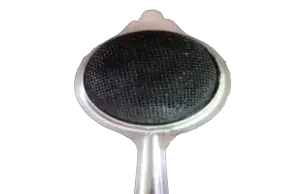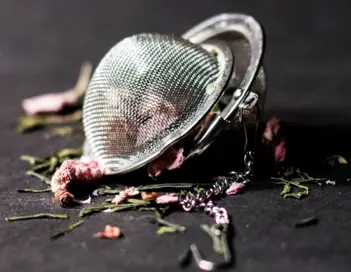Making a tasty flavorsome cup of tea can be a great – if minor experience in the grand scheme of life. Even the act of preparation and pouring can feel like an absorbing and rewarding pastime in itself. But I’ll need to tell you how to clean a tea infuser – it’s just one of those things you need to know if you’re turning into a tea drinker!
So how to clean your tea infuser. Here’s the how-to guide. The ways are actually many and varied, some depend on what type of infuser you have. All involve some effort and a selection of materials. But it’s all worth it to get your tea infuser looking new! So let’s look at the recommended ways to find one that works for you…
Why do Infusers and Tea Strainers Become Stained?

There are two reasons why tea is such a hit and is the second most-drank beverage after water. That is down to two molecules collectively known as Polyphenols, which are contained within the dried leaves of the Camellia Sinensis plant, Theanine, and Theophylline.
Both Theanine and Theophylline are mainly responsible for the effects of tea. They directly affect the nervous system, reducing stress and other benefits. To discover more on the makeup of tea see my article on What is Tea.
The main point is these two molecules are electro-charged and thus have a tendency to ‘stick’ to metals. The result is natural debris attracted to the surface of your tea infuser or tea strainer.
So the next time someone asks why the spoon or strainer gets stained. You can confidently say, “That’s down to two molecules within the Camellia Sinensis plant called Theanine and Theophylline. These Polyphenols have a tendency to ‘stick’ to metals”… and watch the tumbleweed drift gently by!
It WILL Become Stained Over Time
Making tea for yourself during a quiet moment’s reflection. Or sharing with friends across a table during Afternoon Tea is a very satisfying experience. And one not to be taken lightly.
But there’s no avoiding it, like most things where food and drink are involved, there’s an element of cleaning required.
With tea, that can sometimes be how to clean your tea infuser or even how to clean your tea strainer. Because of chemical reactions, it simply will happen sooner or later without constant maintenance.
Has to be said that some of the stainless steel ones do fair better.
If your strainer or infuser is made of plastic, then we’d simply recommend replacing it, rather than trying to clean it. Is it really worth spending even a few minutes of your life cleaning them for the sake of a dollar for a new one?
To be perfectly honest, it may be time to choose a new and exciting infuser! If you have no idea what we’re talking about then read about What is a Tea Infuser.
But, if you’re determined to clean that old faithful plastic strainer, then I still have a few options open to you. …at least, where mild staining is involved.
This is also an option for cleaning your mesh basket used within your teapot – integral or otherwise.
All of these options should work well for LIGHT STAINING, so see what you have lying around the house…
How to clean a tea infuser – Instructions
- Soak in oxy clean or white vinegar for around 4 or more hours, or overnight if the staining is thick. This should remove much of the staining – if not all of it. Rinse thoroughly before its next use. If not, then try the next step.
- Soak it in a combination of hot water in a cup and one teaspoon of baking soda (sodium bicarbonate). Be sure to rinse well after you remove it and before the next use.
- Alcohol should provide some effect for removing the stains, add a quarter cup of Vodka to a cup and fill the rest of the cup with water to the top. Add in your infuser and leave overnight.
- We’d recommend this method if the above options don’t do it for you or you don’t have the right materials to hand. Mix a small amount of bleach and a larger amount of hot water in a container like a washing-up bowl. Around 1/5 bleach to 4/5 water should be plenty.
- Leave your infuser in there for about 15 minutes and it should come out as good as new. Rinse it as much as possible before using it. The danger of using bleach is that the clue is in the title. In some cases, it may not actually be removing all the stain, more just bleaching it out of sight.
If it’s a mesh or perforated infuser, I recommend you assist the methods above further by using a nail brush to help brush away any particles. If they are hard-to-reach places and you have an old toothbrush then use that to try and loosen any further bits.
As with all the previous methods, be sure it’s rinsed thoroughly enough when you remove it and before it’s next use.
The Hard Brushing Bit!
For HEAVY STAINING there is a more aggressive approach. I would define this as having an infuser that has become ‘plugged up’ with particles to the point where it now barely works.
For stainless steel mesh infusers and strainers, do the following. This may not work for all infusers as it depends on the shape and style of the infuser.
- Hold the infuser mesh over a gas flame for around 3 minutes, ensuring that all stained areas are turned a charcoal black. Use a towel or oven mitt if you feel any handle will get too hot to hold whilst you turn and manipulate the infuser over the flame.
- Allow to cool, don’t be concerned if the infuser resembles a charred mess at this point.
- Whilst soaking the infuser in one of the above solutions, use a toothbrush and scrub as hard as possible across the surface of the mesh, dipping in the solution regularly
- Continue this process as the particles begin to fall off the mesh wiring.
- When completed, rinse thoroughly
- The end result should see a revived and nearly new infuser or strainer.
The following Youtube video demonstrates the process…
Don’t do the following…
If it’s a plastic infuser then don’t use bleaching agents on it. They will at worst cause deforming of the plastic which can look terrible and impede its function.
Using harsh bleaching agents on plastic strainers may cause the plastic to become brittle or unstable. And may even leave a residue within the top layer of plastic. This may then transfer to your tea on the next use … eeew!
If you do use any of the above methods, be absolutely sure to rinse your infuser thoroughly before its next use.
Of course, it goes without saying that you should not use the ‘flame-grilled method’ with plastic. Instead use one of the earlier methods – and scrub like your life depends on it!
Silicone Infusers
Because Theanine and Theophylline are attracted to metals, you should find that any staining on a silicon-based infuser should clean off very easily with standard cleaning materials.
Looking After Your Tea Infuser
I’m sure you don’t need me to tell you this, but the best way to keep your infuser from getting clogged is to wash it (or at least rinse it) directly after use. This will prolong the time it takes to get stained up.
Naturally, life’s too short. We’re all guilty of putting the infuser (or strainer) on one side in our eagerness to enjoy our newly made mug of tea. But we all still know cleaning straight after use makes sense *wags finger*
So with this how-to guide, you can learn how to clean tea strainers with baking soda, how to clean tea mesh in general, or even how to clean a mesh strainer.
You can even try this to remove rust from a tea strainer or simply remove the tea stain from your filter. So many options! Although, if you see signs of rust, I really would recommend replacing it.
I hope this guide has been useful, let me know any that you think I’ve missed or those you think work best or not at all – and I’ll happily update the options.

Hello
Why can’t an all stainless steel infuser be put into a dishwasher?
In particular I’m referring to the “Silver Perfect Infuser”, 904044V0076292.
Thank you
Very Nice Blog..!! Thank you for sharing this information. It’s been useful for me as I’m cleaning my infuser for the first time.